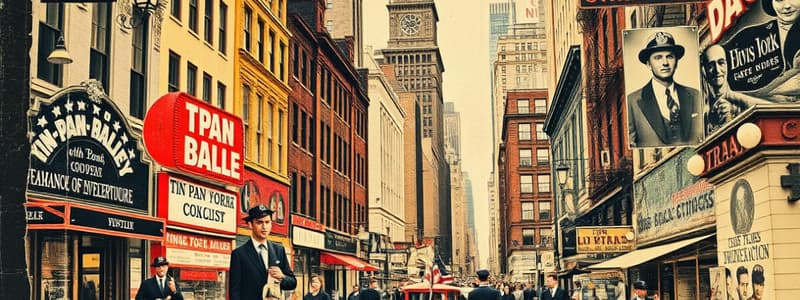Podcast
Questions and Answers
What/where is Tin Pan Alley and why does it have this name?
What/where is Tin Pan Alley and why does it have this name?
It was a collection of sheet music publishers on West 28th Street in New York City, and the noise of musicians playing their pianos sounded like tin pans.
Where did Tin Pan Alley start out and where did it move to?
Where did Tin Pan Alley start out and where did it move to?
It started by Union Square in the 1880s, then moved to West 28th Street.
Who made up Tin Pan Alley?
Who made up Tin Pan Alley?
Songwriters, musicians, and publishers of popular music, mostly Jewish.
How were Jewish individuals viewed during the Tin Pan Alley period?
How were Jewish individuals viewed during the Tin Pan Alley period?
During the 1880s to 1940s, what happened to Jewish composers and musicians?
During the 1880s to 1940s, what happened to Jewish composers and musicians?
Why is Tin Pan Alley important?
Why is Tin Pan Alley important?
What was the style of music typical of Tin Pan Alley?
What was the style of music typical of Tin Pan Alley?
How were most Tin Pan Alley songs written?
How were most Tin Pan Alley songs written?
What is the Assembly Line Structure of songwriting?
What is the Assembly Line Structure of songwriting?
What are the elements of a popular song?
What are the elements of a popular song?
Who composed the Tin Pan Alley song 'After the Ball'?
Who composed the Tin Pan Alley song 'After the Ball'?
Why is the song 'After the Ball' important?
Why is the song 'After the Ball' important?
How was the song 'After the Ball' popularized?
How was the song 'After the Ball' popularized?
What do the lyrics of 'After the Ball' portray?
What do the lyrics of 'After the Ball' portray?
What makes 'After the Ball' a Tin Pan Alley song?
What makes 'After the Ball' a Tin Pan Alley song?
What two famous musicals featured 'After the Ball'?
What two famous musicals featured 'After the Ball'?
What other popular styles did Tin Pan Alley appropriate?
What other popular styles did Tin Pan Alley appropriate?
What were some immigration politics that Tin Pan Alley songs sang about?
What were some immigration politics that Tin Pan Alley songs sang about?
What was the California Gold Rush?
What was the California Gold Rush?
What was the Transcontinental Railroad?
What was the Transcontinental Railroad?
What is 'Yellow Peril'?
What is 'Yellow Peril'?
Flashcards are hidden until you start studying
Study Notes
Tin Pan Alley Overview
- A collection of sheet music publishers located on West 28th Street, New York City, characterized by stacked brownstone buildings.
- Named "Tin Pan Alley" due to the cacophony of music from various songwriters playing pianos simultaneously, resembling the sound of tin pans.
Evolution of Tin Pan Alley
- Originated near Union Square in the 1880s, shifted to West 28th Street over the next 50 years for a more respectable reputation.
- Movement northward mirrored the mainstream acceptance of American music.
Demographics and Culture
- Predominantly comprised of Jewish songwriters, musicians, and popular music publishers, living on the more impoverished side of Union Square.
- Jewish composers and musicians assimilated due to geographical and social integration.
Importance of Tin Pan Alley
- Served as a significant marketplace for popular music, generating hits for Broadway, radio, and Vaudeville performances.
- Many homes had pianos, promoting the sale of sheet music, leading to financial success.
Musical Style and Composition
- Featured simple verse-chorus (AABA) song structures, with easy-to-sing melodies that were both sentimental and catchy.
- Titles prominently mentioned at the beginning and end of songs, enhancing memorability for easier sales.
Songwriting Process
- Collaborations typically involved teams of composers and lyricists.
- Featured an assembly line structure including the creation of a basic tune, refinement by an arranger, lyric writing, title selection, and promotion by song pluggers.
Elements of Popular Songs
- Core components include melody, rhythm, and relatable topics resonating with audiences.
Notable Songs and Their Significance
- "After the Ball," composed by Charles K. Harris, marked the first major Tin Pan Alley hit.
- Its popularity was boosted by a performance from John Phillips Sousa at the 1893 World Columbian Exposition, describing a poignant love story.
Cultural Representation in Music
- Tin Pan Alley songs often included narratives about immigrants, notably Chinese immigration during the Gold Rush era.
- Some songs captured the experiences and challenges faced by immigrants in America.
Historical Context
- California Gold Rush led to a significant influx of Chinese immigrants seeking opportunities, establishing communities in urban Chinatowns.
- The construction of the Transcontinental Railroad hired many Chinese laborers, who faced tough conditions, alongside Irish laborers working from the east.
Social Issues in Music
- Tin Pan Alley songs reflected immigration politics, including themes surrounding the challenges and perceptions of Chinese immigrants, often under the umbrella of "Yellow Peril," depicting a perceived threat to Western society.
Studying That Suits You
Use AI to generate personalized quizzes and flashcards to suit your learning preferences.




